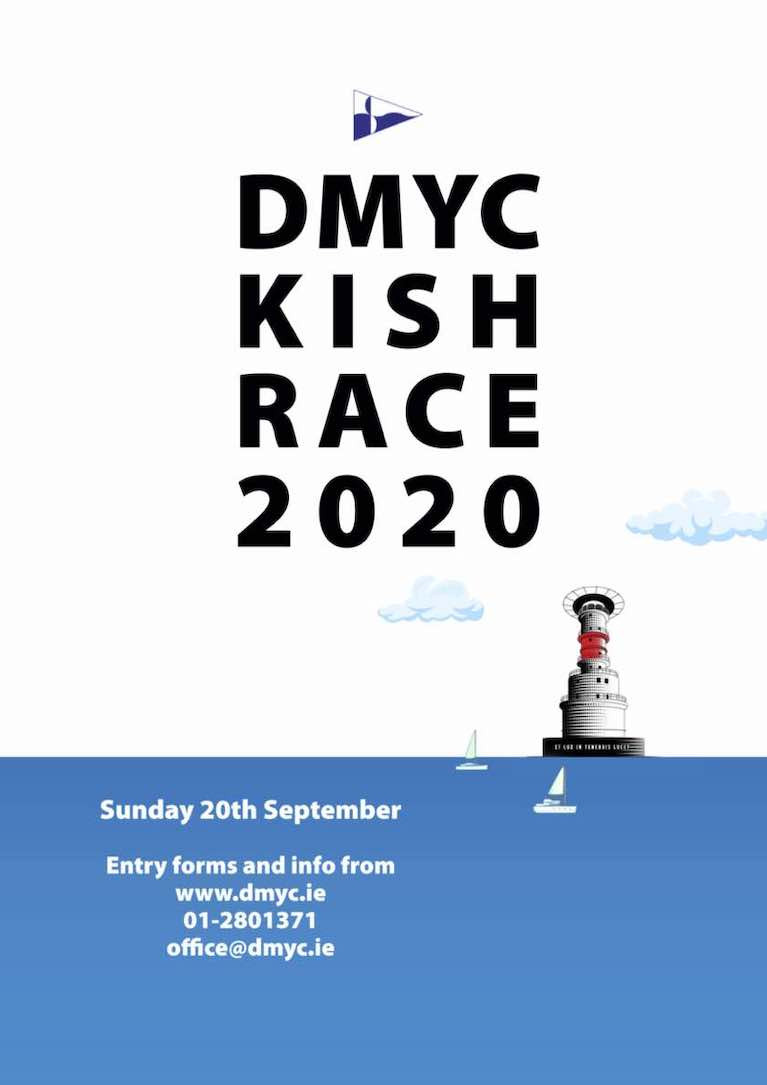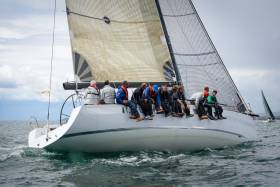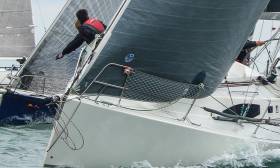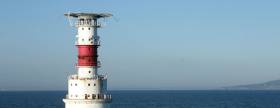Displaying items by tag: kish
Seize the Days! Cartoon Wins New-style DBSC Cruisers 3 Championship In Best of Weekend's Breezes & Sunshine
Two days of sunny Dublin Bay perfection, with light easterlies on Saturday and an initially brisk westerly on Sunday, provided the notably sociable DBSC Cruisers 3 with an ideal launch pad for their new style championship, which produced an oven-ready event simply by combining the penultimate DBSC Saturday Race with the annual DMYC Kish Race on Sunday.
Almost all of the Class 3 fleet turned up for both races, and over two very different contests, there wasn't a single OCS, DNF, or DNC – it was a credit to the Class, and made for some great racing.
Saturday's DBSC race was on the cusp of being cancelled, but the RO wisely postponed for about 30 minutes and sure enough, a light breeze filled in, enough to stage a reasonable race around the bay. The course was wisely chosen so as not to interfere with the J/109 Championships which were being held in close proximity to the DBSC fleet. As the RO described it the conditions turned out to be champagne sailing, a light breeze of just 7kts and an almost flat sea. A great race ensued around 4 marks, ending at the MacLir finish line just outside the Harbour entrance.
 Morning start. All the promise of a great day's sailing as the Kish Race fleet head away from the pier start, with the restored DB21 Garavogue on right and below
Morning start. All the promise of a great day's sailing as the Kish Race fleet head away from the pier start, with the restored DB21 Garavogue on right and below

Sunday's Kish Race was a stunning day out. Forty-one boats crossed the start line off the DBSC Hut, which is no mean feat in itself, and set off on a downwind run to the Kish Light. Conditions couldn't have been better with a 10kt apparent wind and just a slight sea, spinnakers set and many colours flying.
The Cruiser 3's were well up with the leaders and remained so all the way out to the Kish. Then there was a huge fleet split, some going northwest on a port tack up towards Howth, the remainder going southwest towards Killiney on a starboard tack, with both groups being heavily affected by a strong ebb tide, and there's still discussion as to which way paid best.
 Fascinating yacht design mixture, with the Nich 31 left, a Shipman 28 at centre, and the Dublin Bay 21 Garavogue on right
Fascinating yacht design mixture, with the Nich 31 left, a Shipman 28 at centre, and the Dublin Bay 21 Garavogue on right
When the results were posted, there were clear winners in both IRC and ECHO. The Quarter Tonner Cartoon (Ken Lawless & Sybil McCormack) posted an impressive win on IRC on both Saturday and Sunday to take the overall prize, with the Formula 28 Starlet (Kevin Byrne) posting second overall and Maranda (Myles Keogh) coming in third. The ECHO prize was won emphatically by the vintage Beneteau First Papytoo (Frank Guilfoyle), followed by Eleint (Michal Matulka) in second with Cartoon emphasising the solidity of her performance by posting another podium place on third under ECHO.
 The Trapper Eleint (Michal Matulka) on her way to the Kish
The Trapper Eleint (Michal Matulka) on her way to the Kish
 Perfect sailing conditions prevailed out at the Kish LV
Perfect sailing conditions prevailed out at the Kish LV
It all made for a wonderful finale to the season with two days of cracking sailing and some great competition on the Bay. Class Captain Kevin Byrne issued a big thanks to DBSC, DMYC and Colin McMullen for all their help in staging the Championship, and especially to the skippers and crews for taking part to provide a great turnout with a solid showing of boats that augurs well for the future of Cruisers 3.
The prizes will be awarded at the Class Dinner on the 27th November in the Royal St George YC
 The new champion. The Fauroux Quarter Tonner Cartoon at the start of Kish Race in the late summer weather of the championship weekend. Photo: Afloat.ie/David O'Brien
The new champion. The Fauroux Quarter Tonner Cartoon at the start of Kish Race in the late summer weather of the championship weekend. Photo: Afloat.ie/David O'Brien
DMYC Prepares for Annual Kish Race on September 20
Dun Laoghaire Motor Yacht Club (DMYC) has published details of the 2020 edition of its annual Kish Race on Dublin Bay later this month.
The round Kish and back race will take place on Sunday 20th with the first gun at 10.25 a.m.
Starting in the vicinity of Dun Laoghaire Harbour and racing to the Kish lighthouse and back, it is a distance of approximately 28 km.
There will be three starts separated by five-minute Intervals.
- 1st Start Cruiser 0 and 1
- 2nd Start Cruiser 2
- 3rd Start Cruiser 3, 4,5. Shipman and Ruffians
Race organiser Ben Mulligan says that 'as this is the “last major” in the Dublin Bay summer season before the lift out or winter racing, the club is looking forward to an enthusiastic entry'.
Handicapping will be based on ECHO Standard, giving those with revised ECHOs a good chance at the prizes.
Results for the race will be calculated using ECHO standard TCF handicaps, or equivalent. Overall prizes will be awarded for the best performance. (The Kish Race Trophy)
In addition, there will be a Prize awarded for the first Shipman and the first Ruffian and the first in each cruiser class.
Unfortunately, this year organisers cannot offer the hospitality of the DMYC for the prizegiving but prizes will be sent to the winners.
The entry fee is €25
Greystones Yacht Wins DMYC 'Kish' Race Rerouted to North Burford
47 boats entered the 2017 edition of the DMYC Kish Race which, in this particular instance, should have been renamed the DMYC North Burford Race as the Race Officer of the day, Neil Colin, adequately judge that there was not a chance to round the Kish in these conditions writes Olivier Proveur.
Download results below as a PDF file
In stark contrast to last year where winds blew F7 to F8, the wind never got established and a paltry 3 to 5 knots 'gusting' 7 to 9 knots at the very most welcomed the competitors, some of which were really struggling to even cross the start line against a strong tide.
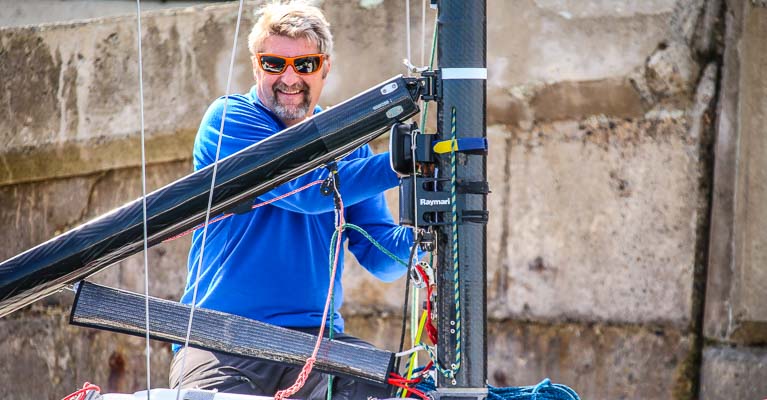 Andrew Sarratt sailing the J70 'Jheetah' from the RIYC was second overall in the light air DMYC Kish Race
Andrew Sarratt sailing the J70 'Jheetah' from the RIYC was second overall in the light air DMYC Kish Race
Many on board wished there would still be a smoker among the crew to 'light up a fag and see where that puff was coming from' but alas, there were no more puffs than smokers!
Once the on board provisions of food and drinks ran out, many decided to call it a day, some on the verge to run aground, some trailing fishing hooks in the hope of 'showing something for their day', some being just too bored, too thirsty or too afraid to use all their Brownie points at home all in one go!
Most who actually persevered managed to cross the finish line before the 16:30pm deadline and a small group of tired but enthusiastic sailors gathered on the DMYC balcony for the prize giving and a well deserved pint...
The big winner of the day was the Grand Soleil 44 Race 'Eluthera', Frank Whelan of Greystones SC, who won with a very comfortable margin of over half an hour on corrected time over second overall boat J70 'Jheetah' (Andrew Sarratt) of the RIYC showing that, in light airs, you either need a lot of canvas or a very small displacement!
DMYC look forward to the 2018 edition when race organisers have promised all competitors 'a nice F3-4 reach to and back from the Kish' after these two most contrasting years.
J109 Sets Course Record in Big Turnout for DMYC Kish Race
Today's winner of the DMYC Kish race from Dun Laoghaire harbour reached the lighthouse on the edge of Dublin Bay in approximately 51–minutes. The J109 Jalapeno may have completed what organisers believe is a course record in the blustery westerly conditions that prevailed. A full photo gallery is here.
On the return leg, a squall blew through the course with 30–plus knots recroded, resulting in 14 boats retiring.
The 41–boat fleet included a wide variety of craft, including many cruisers who never normally race, according to race organisers, Olivier Prouveur and Neil Colin.
Results are below as a PDF file. Photo gallery is here.
Windy DMYC Kish Race Photo Gallery
A fine fleet of mixed sailing cruisers braved south–westerly winds gusting to gale force on Dublin Bay today for the ten–mile Round Kish Lighthouse Race. The DMYC race started at 11am and included many Dublin Bay boats but also visitors from Greystones and Howth. Photo gallery below:
Final Call For DMYC Kish Race, 26 Boats Entered So Far
The DMYC in Dun Laoghaire are reminding sailors that online entry for its Kish race on Dublin Bay closes tomorrow at 19.00 on 24th September.
Looking at the weekend forecast – sailing tomorrow may will be for the heavy weather brigade, but Sunday shows some easing even though the WindGuru is predicting gusts in the low 20’s. Does it suggest a spin around the Kish on Sunday would be an ideal way to close out the season?
'The Kish might not be the Vendee Globe, but it still presents a challenge all sailors like', says DMYC's Neil Colin.
DMYC Kish Lighthouse Race Details Are Announced
The DMYC will hold its annual Dun laoghaire to Kish lighthouse (and back) race on Sunday 25th September.
The DMYC have been staging this race since the early 1980’s when it was a single–handed affair and over more recent years it has become a two–handed race, but in this instance the club hopes there will be a greater participation as a fully crewed race, which might suit the potential autumn conditions better than the historic mid-summer conditions.
The race is also being run under Echo Standard, as compared to the adjusted echo for two reasons. Firstly, so that crews who have had their handicaps reduced due to performance, can enjoy a chance to race on the yachts design handicap, and have a chance of glory. Secondly, To encourage the cruising sailors who shy of formal racing and don’t have IRC or current Echo handicaps to participate.
The online entry form is also designed to accept entries from yachts who are not aware of their ECHO, as additional encouragement to sailors who may be more cruising orientated.
The event is open to all yachts, subject to insurance and standard DBSC Safety Requirements, which all competent yachtsmen should be meet in any event. The DMYC encourages entries from the greater Dublin Bay and East Coast area along with the White Sail fleets.
The Notice of Race and Entry form is here
Saturday's 42–mile ISORA offshore race from Dun Laoghaire features Dublin lighthouses Rockabill and Kish and a finish back at Dun Laoghaire in time to join the apres–sail at Saturday's Royal St George Yacht Club Regatta. Download the race details below.
Howth Yacht Club Double-Handed Yacht Race Challenge to Feature Kish, Rockabill & Lambay
#hyc – Howth Yacht Club will run an open double-handed race on Saturday, August 23, 2014 for both spinnaker cruiser classes and white sail cruiser classes. The course will use the Kish Lighthouse, Rockabill lighthouse and Lambay and will start and finish at Howth's East pier. The course will be approximately 40 miles with a start time of 10am and hopeful finish time of late afternoon.
Double handed sailing is the fastest growing fleet within the RORC race calendar and so this challenge will give a taste of shorthanded sailing to HYC crews and hopefully will attract visitors from other local clubs.
Preparation and participation in the HYC Double handed Challenge is a great way for competitors to build shorthanded sailing skills and have a safe fun passage.
So put this in your diary, pick a crew (just one) and go for a practice sail. Entry forms, Notice of Race and Sailing Instructions will be posted soon.
Sonar Survey Reveals Torpedoed Guinness Ship
The detailed seabed images, which include deck features and complex sand wave structures, were recorded by towed sidescan sonar provided by the Moore Marine Group, and give a visual insight into the defensively armed ship that was sunk by a German torpedo in 1917, seven miles east of the Kish Bank off Dublin.

Photos above and below show topographic seafloor images in 3D, showing the partially buried wreck of the W M Barkley lying at a water depth of 56 metres; with deeper scouring around it down to 72 metres (darker colours indicate greater depths). The images were created from sonar data acquired onboard the Marine Institute's research vessel RV Celtic Voyager, during INFOMAR Programme mapping in 2010 and 2011 with data processed by INFOMAR's Fabio Sacchetti (University of Ulster) and Charise McKeon (Geological Survey of Ireland).

In May 2010, during a large scale mapping survey in the Irish Sea by INFOMAR, a national marine study run by the Marine Institute and the Geological Survey of Ireland, identified a seabed feature which, to the trained eye, was discernable as a potential shipwreck lying in the same position recorded on the Admiralty Chart, the EU wreck site and UK Hydrographic Office wreck site directories, as well as a survey conducted in the 1980s as the last known position of the W.M.Barkley.
Viewing the spectacular imagery of the shipwreck Minister for Communications, Energy & Natural Resources, Pat Rabbitte, said "I am delighted to note the continued excellence of the valuable work being carried out under the INFOMAR project. These images from the deep reveal a unique view of part of Ireland's marine heritage and I am delighted to announce details of INFOMAR''s annual seminar to be held in Galway on November 16 and 17th."

Eibhlin Roche - Guinness Archivist, Guinness Storehouse with the model of the W.M. Barkley. Photo: Jason Clarke Photography
Ninety four years ago on the dark night of October 12th 1917 the W.M.Barkley was torpedoed without warning by the German submarine UC-75. Within minutes the ship, which was owned and operated by the Guinness Company of Dublin, broke in two and sank, taking with her to the bottom four men including her Captain and leaving the rest of her crew to face the sea in an open lifeboat. Now, the darkness where the ship has lain in pieces has been disturbed, probed by fingers of sound that are mapping the seabed in incredible details and bringing to light the position of this famous Irish shipwreck.
"As the first Guinness owned ship, the W.M. Barkley played an important role in the story of the transportation of GUINNESS beer overseas," said Eibhlin Roche, Guinness Archivist. The events of the night of 12th October 1917 are very much part of the history of Guinness that is recorded in the Guinness Archive. It is exciting to finally know the exact resting place of the W.M. Barkley."
A scale model of the W.M. Barkley is on display in the Transport Gallery of Guinness Storehouse remembering the lives of the Guinness men who both perished and survived the events of 12th October 1917. These are stories of tragedy and bravery portraying Irish traditional values, and how they were brought to light with the application of cutting-edge technology.

Koen Verbruggen (GSI), Minister Pat Rabbitte, Dr. Peter Heffernan (CEO, Marine Institute), Eibhlin Roche (Guinness Archivist, Guinness Storehouse) and David Smith (Country Director, Diageo Ireland) Photo: Jason Clarke Photography




























